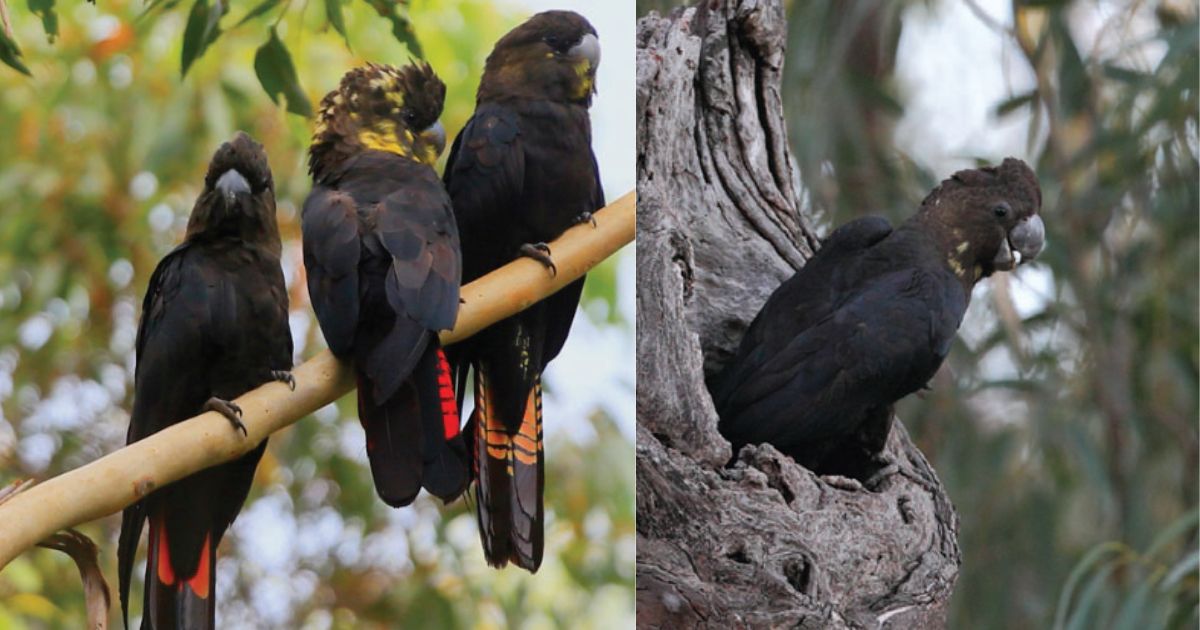Glossy Black-Cockatoo
Calyptorhynchus lathami
The Glossy Black-Cockatoo is the smallest black cockatoo in Australia. It has a dull blackish-brown plumage with a massive, bulbous bill and a short crest. Males have a prominent red tail panel, while that of females is yellow to orange-red. The coloured tail panel is barred black in juvenile birds, with the extent of barring decreasing with age. The female usually has irregular pale-yellow markings on the head and neck, and may have yellow flecks on the underparts and underwing.
Status
- Conservation status in NSW: Vulnerable
- Commonwealth status: Vulnerable.
Habitat
Glossy Black-Cockatoos are usually seen in pairs or small groups feeding quietly in She-Oaks. Glossy Black-Cockatoos inhabit open forest and woodlands of the coast and the Great Dividing Range and in the Central West and Tablelands areas where stands of She-Oak and large hollow bearing trees occur for breeding habitat.
In the Riverina, Glossy Black-Cockatoos are associated with hills and rocky rises, but also recorded in open woodlands dominated by Belah (Casuarina cristata).
Diet
Glossy Black-Cockatoos feed almost exclusively on She-Oak species (Casuarina and Allocasuarina), some local favourites include:
- Casuarina cristata
- Allocasuarina verticillata
- A. gymanthera
- A. luemanni
- A. diminuta.
Breeding
Glossy Black-Cockatoos are dependent on large, hollow-bearing eucalypt trees for nest sites where a single egg is laid between March and May.

Why is the Glossy Black-Cockatoo Threatened?
- Habitat and feed-tree loss and fragmentation due to clearing of trees
- Competition for nests from Galahs and introduced honeybees
- Loss of living and dead hollow bearing trees
- Loss of habitat trees from fire damage during wildfire, hazard reduction and stubble burns
- Feral cats and possums, which raid the birds’ nests.
Protecting the Glossy Black-Cockatoo
Glossy Black-Cockatoos are a favourite amongst conservationists and the broader community, being well known for their gentle nature, quirky behaviour and distinct colouration. Central-Inland NSW is home to a significant, distinctive but declining Glossy Black-Cockatoo population concentrated in forest and woodland areas.
- Download the Birdlife Australia Glossy Black ID handbook.
Download the factsheet PDF, 716.06 KB.
For more information, contact:
South-East Local Land Services:
- Andy Taylor, Senior Natural Resource Management Advisor
E: andy.taylor@lls.nsw.gov.au
Central Tablelands Local Land Services:
- Viv Howard, Senior Land Services Officer
E: vivien.howard@lls.nsw.gov.au
Central West Local Land Services:
- Bec Mooy, Senior Land Services Office
E: rebecca.mooy@lls.nsw.gov.au
See more natural resource management projects supporting habitat rejuvenation for our native plants and animals in NSW.
Bringing back the glossy black-cockatoo
Central Tablelands Local Land Services, in collaboration with Charles Sturt University and Habitat Innovation & Management will supply and install 35 specifically designed Habitech Great Glossy Black-Cockatoo nest boxes on private and public land throughout the Central Tablelands and Central West regions through the Bringing Back the Glossy Black project.
This project aims to raise community awareness of the current threats to the Great Glossy-Black Cockatoo by facilitating workshops with rural landholders and the broader community.
Read more about the Bringing back the Central Tablelands Bringing back the Glossy black-cockatoo project.